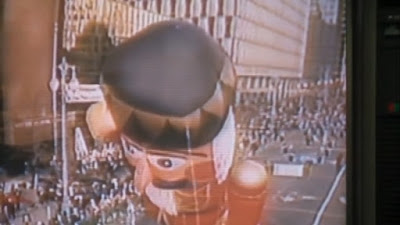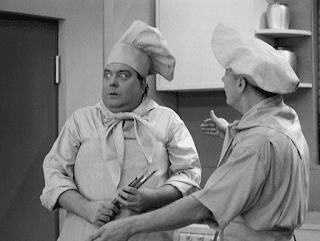I definitely remember being almost uncontrollably excited for the nights that Mom and Dad would take us to Pizza Hut. Even as a fairly young kid, I loved to read, so it made it quite easy for me to enjoy participating in the "Book-It Club," where kids could earn free pizza just for reading. I was so excited for the waitress to add a new star-shaped sticker to my giant holographic "Book-It" button.
As we got older, we began going less and less to Pizza Hut and would more often go to local pizza parlors. Growing up in the shadows of New York City, the local pizza was hard to beat. Seriously. My wife and I joked about missing "the pizza and the bagels" when we moved out of New York, but I'll be darned if we can't find a decent slice of pizza or a good bagel around here.
The "Greasy, Orange, Corner Pizza" (the best pizza is always greasy, orange, and from a corner shop) that we got from a few places around town not only beat Pizza Hut in flavor, but we didn't have to drive thirty minutes just to get there or dine in a noisy restaurant. We finally settled on our new favorite place by the old hardware store, and if I'm not mistaken, Mom and Dad still get pizza from there today.
Pizza Hut is a big piece of my generation's nostalgia for the past, as my pal and podcast partner Mickey knows best. He's by far and away the person I know that is most knowledgeable on the topic of Pizza Hut. His great article about the beloved chain has gone viral a few times and given him quite a bit of recognition over the years. In his article, he sums up a lot of what we all loved about Pizza Hut.
One of my favorite promotions of the 1990s, and one of the many things I remember begging Mom to buy until she finally relented, was Pizza Hut's BigFoot Pizza.
The BigFoot Pizza was a large rectangular pizza measuring 2 square feet (12 inches by 24 inches). It was so large that it was served in a bag rather than a box. Cut up into 21 slices, the BigFoot was ideal for large families, business lunches, little league teams, birthday parties, or any large group of people. Customers could choose up to three different toppings on each order.
Much to my childish delight, and really the reason I wanted Mom to buy the pizza so badly, was that the BigFoot Pizza featured a cartoon mascot. The cartoon Sasquatch wore a green tank top and swimming trunks and was the epitome of 1990s surfer-dude cool. Plus, he was a Sasquatch! What kid wouldn't love it?
Aside from the advertisements, many people also fondly remember the promotions that went along with this sasquatch-sized pizza. The pizza chain would team up with companies such as HBO or Blockbuster Video to give away free products with the purchase of a BigFoot. One of the most successful and popular tie-ins included receiving a free video rental at Blockbuster with your BigFoot Pizza.
A pizza and a video rental. I don't think an evening in the 90s could be any better. Or today, honestly.
BigFoot and Blockbuster Video
Different variations on The BigFoot were sold during the 90s, with the "BigFoot Big Six" being the most popular. For the same price as a standard BigFoot Pizza, a customer could select up to six toppings rather than three. A variant with four meat toppings (beef, pork, pepperoni, and ham) was sold as the "BigFoot Meaty Madness."
During the early 90s, Little Caesars Pizza began pulling customers away from Pizza Hut and Domino's. Research at the time showed that it wasn't based on taste or convenience but rather the financial value of getting more pizza for your money. Put simply, Little Caesars was cheaper, and Pizza Hut had to do something to create something for the cost-value-seeking customer.
Reggie Fils-Aime, best known for his tenure as President of Nintendo of America from 2006-2019, had been the Senior Director of National Marketing for Pizza Hut during the early 90s. Reggie is the one attributed to pushing for BigFoot to be brought to market. He's also the man behind the Big New Yorker, another Pizza Hut pizza with very large triangle-shaped slices for those customers seeking value.
BigFoot Pizza was all about value for the consumer. The amount of pizza in a BigFoot was 25 percent more than TWO of their 12-inch medium pies, which, according to Pizza Hut, is their most ordered combination. In one order of the Bigfoot, a family could get more pizza than buying 2 medium pies; a cost savings not lost on the pizza-buying public.
When Pizza Hut surveyed actual buyers of the BigFoot, they weren't surprised to learn that the people buying it were groups looking for value: Teens, college students, and young families with small children.
According to Larry Whitt, the Pizza Hut Vice President of Public Affairs, the initial test results for BigFoot were pretty good. In early 1993, he said, "Thus far, we are very pleased with the results. We've had a lot of new faces coming into our units to try it."
Based on the impressive results of the test run, the BigFoot was planned for a May 1993 nationwide rollout. When it finally debuted, it was the first nationwide launch from Pizza Hut since the "hand-tossed" pizza in 1988. Still, Pizza Hut wouldn't acknowledge Little Caesar's as competition or the reason behind the creation of The BigFoot. In response to questions about Little Caesar's Big! Big! Pizza, Whitt would only say that BigFoot was developed to make itself more relevant in the value segment.
This classic commercial features a very, very young Haley Joel Osment
Pizza Hut ran a series of commercials that many of us Pizza Hut fans fondly remember. Most had the early 90s fast-paced music and high-energy quick cuts that we are accustomed to from that era. They were only missing BigFoot himself, as most commercials only showed large animated footprints and BigFoot's big foot. It was only on the early versions of the carryout bag or in print ads that we got to see the full cartoon Sasquatch that we children loved.
Instead of using the BigFoot character as the face of the brand, Pizza Hut marketing geniuses created a character called "Pizza Delivery Guy," played by Ricky Dean Logan. Logan would go on to act in several low-budget horror films and, according to IMDB, is most famous for playing a member of Griff's gang named Rafe "Data" Unger in Back to the Future II. Pizza Delivery Guy was ok, but the use of the Sasquatch would have been much better.
Pizza Hut was fairly aggressive in its early advertising of The BigFoot, spending millions on billboards, newspapers, magazines, and television ads. Pizza Hut would eventually lease a giant blimp, at a reported cost of $4 million, to fly around the country advertising their new, very large pizza.
Unfortunately, something went wrong when the BigFoot Pizza Hut Blimp was flying over New York City on July 4th, 1993. The blimp rapidly deflated and made an emergency landing (crashed) on top of an apartment building. Thankfully, no one was hurt. This event, however, became a big deal at the time and received a lot of coverage in newspapers and on the evening news. While you'd think that would give Pizza Hut a black eye, it was actually free national advertising for the chain and The BigFoot.
Pizza Hut, at first, was elated at the product's potential. At its peak in mid-to-late 1993, The BigFoot represented 18 percent of Pizza Hut's sales. The BigFoot was also financially successful, bringing in $5.7 billion in sales for the chain over 9,800 locations in 1993 alone!
By December 1993, Pizza Hut was convinced they had a long-term hit on their hands. Sales increased by twenty percent in Minneapolis and Las Vegas alone when the mega pie was launched in those markets.
Company Spokesman Rob Doughty said, "We expect in the next 12 to 18 months that Bigfoot will be a billion-dollar brand for us.”
By the summer of 1994, the percentage of sales had fallen to only 8 percent (down from 18%) of all sales and was trending further south.
Unfortunately, the pizza itself had issues.
At the time, Pizza Hut's pizza was made in the restaurant itself. Making a BigFoot required employees to stretch the pizza dough across a very large pan while making sure the cheese and toppings were spread evenly. The dough was said to be very fragile and tore easily, so employees had to be extra careful when working the dough into the corners of the pan when preparing the pie. If the dough tore, it was often disposed of since it was extremely difficult to work back together. This resulted in higher waste and reduced profits. Making a BigFoot was a slow and tedious process that often led to sloppy-looking, hastily made pies that resulted in many unhappy customers.
While the BigFoot was beloved by many Pizza Hut fans such as myself, employees of the chain continue to claim it was a logistical nightmare. Specialized pans, boxes, and dough were required, which increased employees' workload and decreased the restaurant's storage space.
Overall poor quality became the largest factor in the pizza-eating public's decision to stop purchasing The BigFoot. Customers who tried The BigFoot and compared it to Pizza Hut's famous pan pizza often found the quality of The BigFoot to be lacking.
Delivery drivers didn't have much success either, based on the shape and size of the pie. Two square feet of pizza in the shape of a giant rectangle does not lend itself to an easy delivery. Also, Pizza Hut's decision to use bags instead of boxes led to a delivery disaster more often than not.
Shortly after The BigFoot debuted, Pizza Hut's competition began to enter the large pizza market. In 1993, in response to the BigFoot, Domino's released The Dominator. Longer than both Pizza Hut and Little Caesar's biggest pizzas, the Dominator measured in at a whopping 10 inches by 30 inches long.
By comparison, Little Caesar's Big! Big! Cheese Pizza offered up two 11 by 11-inch Detroit-style Pan Pizzas that weighed in at a massive 5 pounds!.
Both Dominos and Little Caesars would face the same production and quality issues as Pizza Hut, eventually leading to the demise of these BigFoot-sized competitors as well.
Many people claim that BigFoot disappeared in the late 90s, however, some websites show coupons and local advertisements for the pizza as late as 2008. Many regional locations decided to stop selling the pizza before then, but "out-of-sight, out-of-mind" plays a big part here. Once people decided they weren't interested in purchasing the BigFoot, it quickly became forgotten about and just another item overlooked on the menu in favor of their old favorites.
Many an internet petition has been started begging Pizza Hut to revive the BigFoot Pizza. Several years ago, Pizza Hut released the "Big Italy Pizza" and later the "Pan-ormous Pizza," which were both similar to The BigFoot in that they were very large pizza pies. They did not catch on, either, and both have disappeared.
However, early this year (2023), Pizza Hut brought back another fan-favorite, the other creation of Reggie Fils-Aime, The Big New Yorker. While not a giant rectangle-shaped pie featuring a cute little BigFoot mascot, the Big New Yorker has been (by all accounts) a successful relaunch. Will it stay that way, or is the success only driven by nostalgia seekers who will grow tired of the product once again?
Only time will tell.
Do you remember the BigFoot? Tell me about your memories in the comments section below!










.png)




Comments